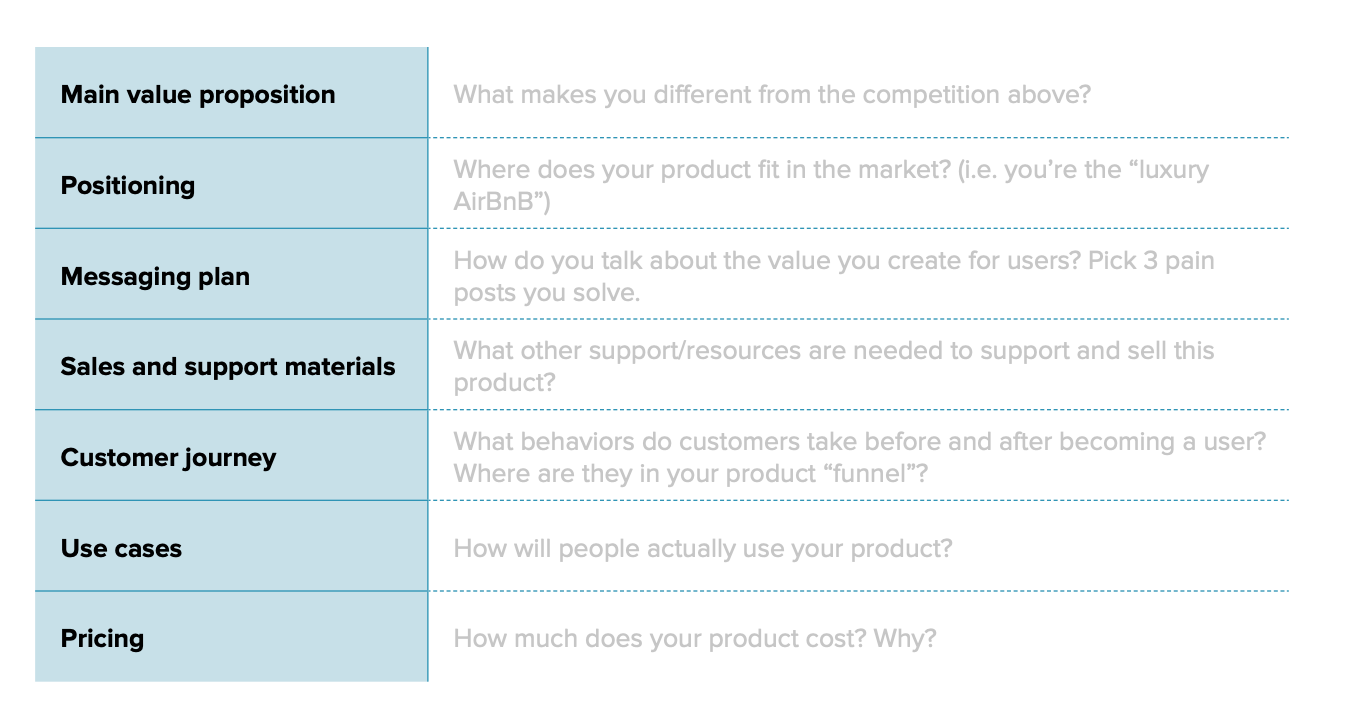322. GTM strategy [w/ free template] 🏁
A marketing guide to creating a GTM strategy and GTM launch for your brand and your product
Hi there 👋
How early do you start planning for the quarter ahead? Believe it or not, I’ve already put the wraps on Oyster’s marketing strategy for Q3, and I finished a full six weeks before the start of the quarter. This is atypically proactive of me — I normally deliver strategy just a couple weeks before the quarter starts. What have you found to be most effective for you or your teams?
Wishing you a great week ahead (and a fun Q3 planning process if you’re into it),
Kevan
(ᵔᴥᵔ)
Thank you for being part of this newsletter. Each week, I share playbooks, case studies, stories, and links from inside the startup marketing world and my time at Oyster, Buffer, and more.
Say hi anytime at hello@kevanlee.com. I’d love to hear from you.
Your Guide to Creating a GTM Strategy (with free template)
Among the many marketing acronyms — and there are a lot! — few have the breadth and depth and ambiguity of GTM. If you know what the three letters stand for, then you probably have an opinion on what GTM means based on your prior experience, your current experience, or a combination of the two. There are no wrong answers about a GTM definition. The only mistake is to be misaligned with how others define GTM within your company.
To add another perspective to the mix, here’s what GTM means to me.
GTM, which stands for Go-To-Market, is the way you design your marketing and sales process to address a meaningful customer problem, to deliver your solution to that specific market, and to drive your business growth.
I’ll go into much more detail in to GTM strategy below, but if you’re just here for the free template, then click here to access.
My GTM reading list includes The Proven Process for Developing a Go-to-Market Strategy (HubSpot), 10 Go-To-Market Strategy Examples and Templates by Upscope), and Build Your Go-to-Market Strategy Template (Monday.com). These articles generally align to my GTM definition (confirmation bias); there are many, many more GTM articles out there.
In my experience, the most confusing element of GTM is that it is used generously to describe 1) the way that an entire company brings its platform of products to market, 2) how each product line individually comes to market, and 3) how individual features get launched. Some teams even use GTM to describe campaign plans.
For example, GTM at Oyster could describe:
The GTM strategy for Oyster’s global employment platform
The GTM strategy for Oyster’s product lines like full-time employment, contractors, benefits, etc.
The GTM strategy for individual product launches like new integrations, time-off management, localized benefits, etc.
The GTM strategy for marketing campaigns like our social impact report or our new e-book
🤯
So many GTMs!
Add to this the complication that many companies talk about their marketing and sales org as the GTM team, and you have yourself a cornucopia of GTM confusion.
That’s why I like to draw the line somewhere. As mentioned above, this is my view on what GTM strategy means:
GTM is the way you design your marketing and sales process to address a meaningful customer problem, to deliver your solution to that specific market, and to drive your business growth.
I draw a line for GTM between the GTM strategy for products and the GTM strategy for features and campaigns. In fact, I try not to even call the latter “GTM.” Features and campaigns should have their own launch strategies, to be sure, but I prefer to call these “launches” and to save the letters GTM for the macro strategies of products and product lines. Basically, if it has a firm launch date attached, let’s call it a launch. If it’s ongoing, let’s call it GTM. :)
Putting together your GTM strategy
There are many correct ways to put together a GTM strategy. I’ll share a Kevan template at the bottom of this story as well as links to several other great templates you can use, all of which are unique to one another.
My must-have GTM strategy elements map really close to this slide deck template from beautiful.ai. The elements are:
Define your target market
Identify your customers and your competition
Create your product messaging
Design the monetization model
Develop your distribution plan
Talk about the targets
Build the team
My seven GTM elements are quite similar in scope to many other GTM best practices out there. Take the advice by HubSpot, for instance, which names these four must-have elements for any GTM:
Product-Market Fit: What problem(s) does your product solve?
Target Audience: Who is experiencing the problem that your product solves? How much are they willing to pay for a solution? What are the pain points and frustrations that you can alleviate?
Competition and Demand: Who already offers what you’re launching? Is there a demand for the product, or is the market oversaturated?
Distribution: Through what mediums will you sell the product or service? A website, an app, or a third-party distributor?
Let’s touch on each of my seven elements in a bit more detail …
1. Define your target market
This initial step of market definition may be one of the easier steps to take because a lot of your high-level market attributes will be obvious. Take this advice from Monday.com for instance:
The first step you’ve got to take is to define your target market, or the specific group of individuals you want to sell your new product to. Start by defining whether this launch is targeting business-to-consumer (B2C) customers or business-to-business (B2B) customers.
Whether or not you’re selling B2B or B2C is pretty broad strokes. For instance, a company like Gong, which sells sales software, is pretty clearly B2B. But then you have cases like we had at Buffer, which were not so cut and dry. We had more of a B2C2B design.
Some things you’ll want to identify at this stage:
Are you B2B or B2C?
What is the TAM for your market?
What are the primary industries you’ll target? (e.g. VC-backed tech, DTC)
What size companies will you go after? (e.g. small business, mid-market, enterprise)
2. Identify your customers and your competition
After you’ve defined the market, you’ll next want to identify your buyer personas. Typically there are a number of people involved in making a software purchase (six to 10, according to Gartner). You’ll find these people playing one or more of the following roles:
The initiator — the person who first comes across your product
The user — the person who uses the product regularly (the core focus of a PLG GTM)
The influencer — the person who convinces others that the product is needed
The decision maker — the person who gives final approval to purchase
The buyer — the person who approves the budget
Final approver — a supercharged decision maker in the case that a buying decision needs executive sponsorship
Gatekeeper - anyone who may be a blocker in getting the product implemented or approved (like the IT department in charge of data security of vendors)
When creating your GTM strategy, you’ll want to identify the main roles involved in the buying decision for your product and build out personas for each person.
While you’re in this research phase, I also like to add research into the competition. One of my favorite ways to show the competitive landscape is with a matrix, divided by two axes. The most common one is Emergents, Rivals, Ankle Biters, and Contenders, and it’s determined by number of sales opportunities and win rate. Crayon put together a great guide to competitor matrices here.
I’m also a fan of the G2 matrix, which splits competitors according to their market presence and their customer satisfaction. (There are way too many competitors listed in this matrix, btw — you only need the top five to 10.)
3. Create your product messaging
Once you’ve determined your customers and built their personas, it’s time to add messaging that speaks to the unique needs of each persona.
There are a handful of ways to do this. Let me show you a couple of my favorites.
First, the folks at Planio put together a great and simple GTM strategy template that includes fill-in-the-blanks for messaging, positioning, and enablement.
You can build out value props, messaging, and sales and support materials for each of your buyer personas. Plus, what’s great about Planio’s setup is that it includes a holistic view of the customer journey from beginning to end, which will help you identify the right messaging and the right times to engage with your personas.
Second, we use a messaging framework at Oyster for each of our launches, and I’ve borrowed parts of it to include in GTM strategy as well. The framework maps to this template from Stefan Groschupf of Sales Hero. Name your persona’s pain points, your product’s solution to that pain, and the message that connects the two.
Then to confirm you’ve got your messaging right, test it out. You can use a small portion of ads budget to test on different channels to different audiences with different messages.
4. Design the monetization model
There’s a host of factors to consider with the monetization model, so I’m way oversimplifying by just pointing you to this great article by Baremetrics:
You’ll find tons of great ideas in there. Personally, I’m a huge fan of any type of pricing model that is usage-based, meaning that the more a customer uses your product and is successful, the more they pay (for instance, an email platform that charges based on subscriber count).
5. Develop your distribution plan
This is where you can combine any of your existing marketing strategies and sales strategies. Distribution simply means how you go about telling the world your product exists, capturing that attention into leads or users, and nurturing those leads or users into paying customers.
Sounds a lot like a multichannel marketing strategy, right? If you already have your multichannel strategy in place, you can put it here in the GTM strategy. Here’s a resource that can help you think about all the different ways to distribute:
6 & 7. Talk about the targets & build the team
These last two elements of GTM are a bit more straightforward and are especially useful as you’re socializing your GTM strategy within your company: telling folks which metrics you’ll be accountable to watching and showing folks who will be working on the GTM plan.
A product launch playbook for feature launches
As I mentioned above, many teams consider GTM as a catchall for any type of launch. The process I’ve outlined so far leans more toward the macro strategic elements of launching a product or product line. A lot of these themes still apply for feature launches, too, but I tend to put a different spin on them.
Here’s my process for feature launches and new marketing campaigns:
As marketing leaders, we should constantly be thinking about ways to evolve our GTM.
Here’s a template you can use to create your initial GTM strategy and to keep evolving it over and over again as the markets change and your product grows.
And if this template doesn’t do it for you, there are plenty more to choose from …
Templates galore!
A huge variety of templates from smartsheet. Be warned: some of them are loooong (like the 20-page GTM overview).
Sample slide template from beautiful.ai
Sample slide template from Pitch
Notion’s GTM launch plan. Note: this is for feature launches in particular, not entire products or product lines.
Misc.
Ladder’s growth tactics playbook. Nearly 800 growth hacks from fast-growing startups worldwide.
About this newsletter …
Hi, I’m Kevan, a marketing exec based in Boise, Idaho, who specializes in startup marketing and brand-building. I currently lead the marketing team at Oyster (we’re hiring!). I previously built brands at Buffer, Vox, and Polly. Each week, I share playbooks, case studies, stories, and links from inside the startup marketing world. Not yet subscribed? No worries. You can check out the archive, or sign up below:
Thank you for being here! 🙇♂️
I’m lucky to count folks from great brands like these (and many more) as part of this newsletter community.









